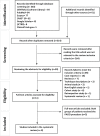The Effectiveness of Periodontally Accelerated Osteogenic Orthodontics (PAOO) in Accelerating Tooth Movement and Supporting Alveolar Bone Thickness During Orthodontic Treatment: A Systematic Review
- PMID: 35582021
- PMCID: PMC9107094
- DOI: 10.7759/cureus.24985
The Effectiveness of Periodontally Accelerated Osteogenic Orthodontics (PAOO) in Accelerating Tooth Movement and Supporting Alveolar Bone Thickness During Orthodontic Treatment: A Systematic Review
Abstract
The current review aimed to critically and systematically evaluate the available evidence regarding the effectiveness of periodontally accelerated osteogenic orthodontics (PAOO) in accelerating orthodontic tooth movement and supporting the alveolar bone. Additionally, this review aimed to analyze the untoward effects of this procedure and the patient-reported outcome measures. A comprehensive electronic search was performed on 10 databases in addition to a manual search to retrieve all relevant studies. Randomized controlled trials (RCTs) were only included in this review. The interventional group was the PAOO procedure, whereas the control group was either a non-accelerated traditional fixed orthodontic treatment or an accelerated treatment using any other intervention. The Cochrane risk of bias tool for randomized controlled trials (RoB 2) was employed to estimate the risk of bias in the included studies. The current review included eight RCTs evaluating 175 participants (63 males and 112 females) with a mean age ranging from 18.8 to 29.6 years. Five of them assessed the effectiveness of PAOO versus traditional orthodontic treatment, i.e. without any adjuvant surgical intervention. At the same time, the remaining three studies evaluated the effectiveness of PAOO versus corticotomy-only as an adjunctive procedure. The PAOO accelerated the leveling and alignment stage from 39% to 47% and accelerated the retraction of the upper anterior teeth from 41% to 61% compared to conventional orthodontic treatment. One study only indicated that PAOO reduced treatment time by 30.3% versus a corticotomy-only as an adjunctive procedure. No significant side effects have been reported with the PAOO procedure. The PAOO procedure was effective in accelerating orthodontic movement and tended to increase the thickness of the alveolar bone. But most periodontal outcome measures regarding PAOO application were not comprehensively covered in the included trials.
Keywords: accelerated tooth movement; acceleration of leveling and alignment; alveolar bone thickness; bone density; bone grafts; conventional orthodontic treatment; corticotomy; patient-reported outcome measures; periodontally accelerated osteogenic orthodontics (paoo).
Copyright © 2022, Alsino et al.
Conflict of interest statement
The authors have declared that no competing interests exist.
Figures



References
-
- Assessment of changes following en-masse retraction with mini-implants anchorage compared to two-step retraction with conventional anchorage in patients with class II division 1 malocclusion: a randomized controlled trial. Al-Sibaie S, Hajeer MY. Eur J Orthod. 2014;36:275–283. - PubMed
-
- Evaluation of treatment outcomes of en masse retraction with temporary skeletal anchorage devices in comparison with two-step retraction with conventional anchorage in patients with dentoalveolar protrusion: a systematic review and meta-analysis. Khlef HN, Hajeer MY, Ajaj MA, Heshmeh O. Contemp Clin Dent. 2018;9:513–523. - PMC - PubMed
-
- En-masse retraction of upper anterior teeth in adult patients with maxillary or bimaxillary dentoalveolar protrusion: a systematic review and meta-analysis. Khlef HN, Hajeer MY, Ajaj MA, Heshmeh O. J Contemp Dent Pract. 2019;20:113–127. - PubMed
Publication types
LinkOut - more resources
Full Text Sources
